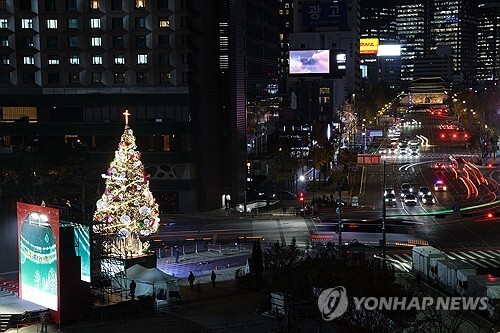 |
| ▲ This photo, shows visitors in Yong-neup, full of fog. (Yonhap) |
 |
| ▲ This photo, shows Yong-neup, where water is always flowing. (Yonhap) |
 |
| ▲ This photo, shows the entrance of the large Yong-neup. (Yonhap) |
 |
| ▲ This photo, shows the poop of leopard cats. (Yonhap) |
 |
| ▲ This photo, shows the trail along the Yanggu Arboretum. (Yonhap) |
 |
| ▲ This photo, shows the DMZ Wildlife Eco Center. (Yonhap) |
SEOUL August, 17 (Yonhap) --The swamp, which was wet with rain and fog, was mysterious as if a dragon would suddenly appear. Yong-neup, the only mountainous wetland in Korea, has a beautiful scenery and a unique ecosystem. It seems that it must be included in the "trip of a lifetime" list.
◇ The highest wetland under the sky
Wetlands rich in ecological resources are abundant in lowlands like rivers and beaches. However, there is one wetland located on a high mountain in Korea. It is Yong-neup, located at the top of Daeamsan Mountain in Yanggu, and Inje, Gangwon Province.
Daeamsan Mountain is 1,304m above sea level and Yong-neup is located at 1,280m above sea level, close to the summit. This is very rare around the world.
Yong-neup, the highest swamp in Korea, is constantly surrounded by a fog and looks like it might reach the sky. It's a mysterious scenery that easily explains the reason of the legend that says a dragon rests and goes.
Daeamsan Yong-neup was known to the academia during the study of the DMZ ecosystem in the 1960s. After the discovery of North Hamgyong Province and Baekdusan Mountain, Yong-neup is the third highland wetlands to be discovered on the Korean Peninsula.
Yong-neup has an area of 1.36 square kilometers, the size of two soccer fields. It consists of a large Yong-neup, a small Yong-neup, and a baby Yong-neup.
How did a swamp form on top of a high mountain? The key to unlocking the secrets of Yong-neup is the cold and humid climate. Yong-neup feels cold even in midsummer. The sub-zero temperature continues from October to May of the following year, and the average annual temperature is around 4℃ with fogs forming in more than 170 days per year.
The fogs continuously supply water to the wetland, allowing the maintenance of the wetland ecosystem. As the temperature is low and the humidity is high all year round in Yong-neup, even after the death of living things, they do not rot and accumulates on the bottom.
Since organic matter accumulates faster than it decomposes, a dark brown organic matter layer is formed on the bottom of the swamp, which is known as the peat layer.
Peat, which is coal that has not been sufficiently carbonized, is formed about 1mm per year in Yong-neup. The average depth of the peat layer is 1m, with the deepest point being about 1.8m. Thus, a peat layer is formed as high as an adult's height.
As a result of analyzing the pollen buried in the peat layer, it has been estimated that the first peat layer was formed around 4,000 to 4,500 years ago. It has been shown that spores were found at the bottom of the peat layer, and had fir, birch, oak, and moonworts in order at a depth of about 80cm below the surface.
Plant remnants accumulated in the peat layer are valuable data for the study of vegetation and climate change on the Korean Peninsula.
The peat layer in Yong-neup is very acidic and contains almost no nutrients at all. Fishes cannot live on swamps formed on peat beds as it is too cold and has almost no nutrients for the fishes to survive.
Instead, a paradise of wetland plants unfold. There are many water-loving plants including creeping sedge, Carex dispalata, silvery sedge, and many more. Rare carnivorous plants, such as sundews and Utricularia, which are mainly found in the cold northern wetlands, also grow in these areas.
Hanabusaya asiatica, endemic to Korea, and alpine plants of the Korean Peninsula, such as Lychnis wilfordii and Trientalis, harmonize to form a unique ecosystem that cannot be seen anywhere else in the world.
◇ 1st Wetland to be registered on the Ramsar Convention on Wetlands
The Yong-neup area is rich is biodiversity with 1,180 species of living things, including 500 types of plants, 40 types of birds, 15 types of amphibians and reptiles, 500 types of terrestrial insects, and 70 types of Benthic invertebrates.
Thirteen endangered wildlife species were also discovered in Yong-neup, including martens, long-tailed goral, leopard cats, flying squirrels,eurasian eagle-owl, and many more.
In the middle of the trail, the poop of the leopard cat was also seen. The poop was full of fur as if it ate a furry animal.
In the Yong-neup area, northern plants and southern plants and animals coexist. This is because Gangwon province includes in the north-south boundary line of flora and fauna.
It is also because the northern flora and fauna that moved south during the Ice age remained and continued to distribute in the cold place even when the temperature kept on rising. The representative examples are the Gentiana jamesii Hemsl, Creeping sedge, and many more.
While Gentiana jamesii Hemsl, a small purple flower that mainly lives in North Korea, bloomed quite a lot, it is not easily seen with the flowers withering due to the rain. In South Korea, this flower can only be seen in Yong-neup.
South Korea has joined the Ramsar Convention on Wetland in 1997 for the conservation of waterfowls and wetlands. During this time, Yong-neup, which has a unique ecology and a beautiful scenery, was registered as the No.1 Wetland under the Ramsar Convention.
The Ministry of Environment has designated this place as a wetland protection area, while the Korea Forest Service designated this place as a protected area for forest genetic resources in 2006.
Ahead of this, the Cultural Heritage Administration designated Yong-neup, the southern part of Daeamsan Mountain, and the northern area around Daewoosan Mountain in Yanggu County as Nature Reserve areas in 1973.
◇ A superb view as if a dragon is flying
It was a rainy day. A cloud of mist hung on the hillside of Daeammsan Mountain all the way till the top. The slender sedges swayed like waves along the wind at Yong-neup. With the gentle movement of the swaying sedge and the fogs, the image of a flying dragon were depicted, and caused the illusion of a dragon between the group of sedges and the fogs.
On a clear day, the vast grasslands formed in Yong-neup can be seen at a glance. Standing at the top of Daeamsan Mountain, the view of Baekdudaegan's ridge from Geumgangsan Mountain and Seoraksan Mountain is phenomenal. The current Chinese character for Daeamsan Mountain is "大巖山" which means big rock.
However, in historic maps and geography maps, including Daedongyeojido (The Great Map of the East Land), which was produced in 1861, has Daeamsan Mountain written as "臺巖山." This means "A place where once can see the scenery in all directions." It is literally that beautiful.
There is a military base not far from Yong-neup, and the whole area is a military reserve. Due to the presence of military bases, there was considerable damage, including the land conversion in part of Yong-neup. The demolition and relocation of military facilities began in 2013 and was completed in 2018.
Although Yong-neup was once forbidden to civilians for its protection, now 250 people are allowed to visit per day as a dedicated trail has been installed and natural environment commentators are always on duty.
◇ Another rare ecological garden… Yanggu Arboretum
In order to visit Yong-neup, one must apply for a tour through the website of Yanggu Arboretum and the website of Daeamsan, Inje County, Yong-neup. Yanggu County and Inje County will then process the application for the visit to the Environment Agency, Korea Forest Service, Cultural Heritage Administration, and the Ministry of National Defense, which are the access permitting agencies.
While the process sounds complicated, it is actually simple. It can be seen as a small effort to pay for the protection of Yong-neup and a systematic exploration. One will be able to visit from mid-May till the end of October, to avoid winter and the wildfire warning period. If one starts from Inje, one can also climb to the top of Daeamsan Mountain.
Yanggu Arboretum is located in the middle of Daeamsan Mountain. It is an ecological town where one can observe rare northern and southern plants in one place.
The Abies koreana lined up along the driveway are the pride of the arboretum. While Abies koreanas were only found in Korea, these days in Europe, it has been distributed as Christmas trees while being called the "Korean fir." These trees grow in Hallasan Mountain, Jirisan Mountain, and many more, between 500 and 2,000 m above sea level.
Although it belongs to Pinaceae, it is not sharp, having no danger of stinging the children's eyes, which makes it even popular. The path in the Korean fir forest is attracting attention as a place for walking, meditation, and healing.
The DMZ Wildlife Eco Center, which exhibits stuffed specimen of animals including wild boar, golden eagle, and badger, and the DMZ Wildflower Bonsai Garden, where one can appreciate the 400-year-old pine bonsai and wisteria bonsai, are also attracting visitors.
(This article is translated from Korean to English by Haemin Kim.)
(END)
(C) Yonhap News Agency. All Rights Reserved























